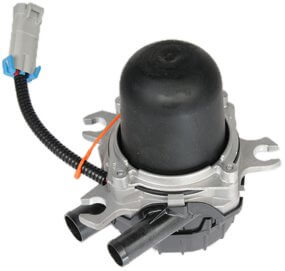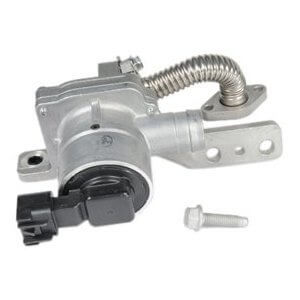Why carmakers install a secondary air injection system
What is a secondary air injection system
A secondary air injection system is part of a vehicle’s emission system. It’s used to reduce emissions during cold starts when the engine is running on a rich fuel mixture to overcome the cold quenching effect of cold combustion cylinders. Unfortunately, the rich fuel mixture doesn’t burn completely causing some of the unburned fuel to exit with the exhaust and flow into the catalytic converter.
The catalytic converter is responsible for burning off the excess fuel, but first it must reach a “light off” temperature of 400° F to 600° F. The hot exhaust gas is what brings the catalytic converter up to light off temperature. Once there, the catalytic converter needs extra oxygen to burn off the unburned fuel. That’s where a secondary air injection system comes into play.
What is secondary air injection pump?
In older vehicles the secondary air injection reaction (AIR) pump AIR was belt driven, but many late model

Electric Air Injection Reaction pump
vehicles use an electric AIR pump. The AIR pump and AIR switching valves are controlled by the PCM. During a cold start, the PCM may wait until the catalytic converter reaches light off temperature, determined by activity readings from the downstream oxygen sensor, and then activate the AIR pump to force outside air into the exhaust manifold or directly into the catalytic converter.
What are the components in a secondary air injection system?
A secondary air injection system requires an AIR pump and one-way switching valves. The valves allow pumped air to flow into the exhaust stream or directly into the catalytic converter while preventing exhaust backflow through the pump when it’s not operating. The air switching valves can be operated by vacuum motors or solenoid valves.

Secondary air one-way valve and solenoid
How does the secondary air injection system and AIR pump work?
During a cold startup the PCM monitors the engine coolant temperature sensor and upstream and downstream oxygen sensors to detect whether to turn on the AIR pump. If the engine temperature is below 195°, the PCM determines the engine is “cold” and commands a rich fuel mixture.
The oxygen sensors have internal heaters that bring them up to operating temperature quickly. Once the catalytic converter reaches light off temperature, the PCM begins to receive downstream oxygen content signals. At that point it operates the AIR pump relay to switch power to the pump (electric pump draws high current, so it needs a relay to switch the power). At the same time, it commands the switching valve to open and allow the pumped air to enter the exhaust stream.
Then the PCM starts a timer. The O2 sensor show should a lean condition due to the extra air in the exhaust stream and it must show the lean condition within a certain time frame. If it doesn’t see the lean condition, that would indicate a problem with the AIR relay, pump or switching valve and the PCM sets a P0411 secondary air injection system flow (low flow or no flow) malfunction.
The PCM activates the AIR relay by grounding the control coil in the AIR relay. By grounding the control coil, the PCM expects to see a voltage drop to almost 0. If it doesn’t get that results, it sets a P0412 secondary AIR circuit malfunction if it finds one. The problem can be a blown fuse, bad relay or an open circuit.
What goes wrong with an AIR pump and AIR switching valves?
Any time a gas is compressed, it heats up and outside air is no exception. In humid conditions, the compression can cause the humidity in the air to condense against the cold metal pump structure and cause internal corrosion. The water can also corrode and impede the operation of the AIR switching valves. Continued corrosion can cause the AIR pump and switching valves to seize, at which point they must be replaced.
©. 2017 Rick Muscoplat
Posted on by Rick Muscoplat